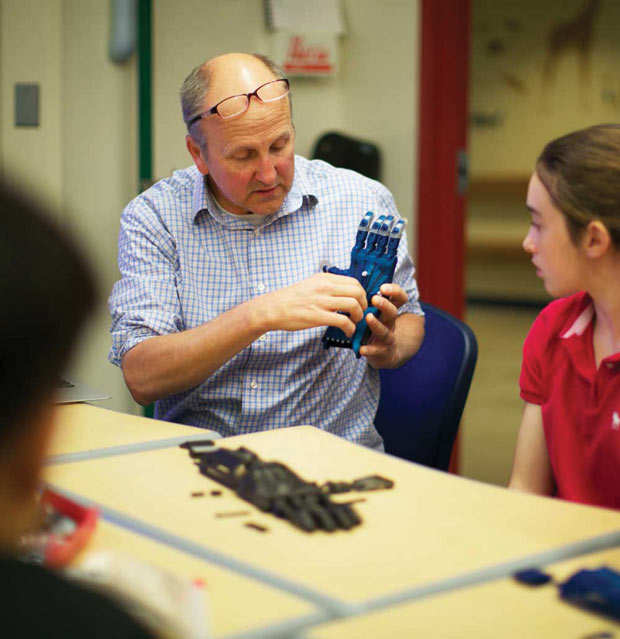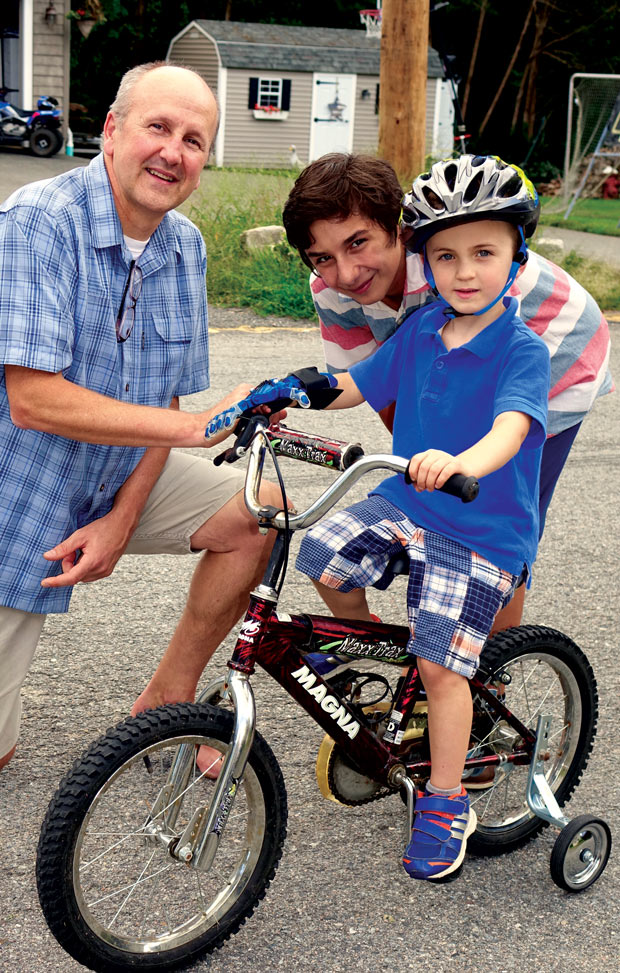Educators Inspire with 3D-Printed Prosthetics

In addition to building prosthetics, Lehrer also teaches his students basic engineering and product design concepts. Image courtesy of Brookwood School.
Latest News
May 2, 2016
Five years ago, when eighth grade science teacher Rich Lehrer found out that his son, Max, would be born without the fingers of his right hand, he was filled with distress. That’s in sharp contrast to now, at the age of 53, when he’s following a new calling inspired by his son’s disability. These days he works to similarly inspire budding engineers to design and 3D print low-cost prosthetics and other devices. Along the way, Max has been the beneficiary of a succession of new, 3D-printed hands that match his growth and improve in function with each iteration.
Lehrer, his students and Max are part of a growing movement to train a new generation of engineers and bring affordable prosthetics and other devices to people who need them—all over the world. In the process, they’re spreading engineering know-how and bringing design software and 3D printers to people who might not have access to them otherwise.
A Helping Robohand
For Lehrer, it all started with an online video in 2013. In it, South African carpenter Richard Van As demonstrated how he had restored some of the function of his right hand with the help of designer Ivan Owen in Washington state after losing four fingers in a shop accident. Van As and Owen collaborated to create a prosthetic they called the Robohand.
Lehrer was so inspired by the video that he contacted Van As that very week to find out how he could get a hand for Max. But in the space of that 30-minute conversation, Lehrer came away with much more.
Realizing that building a hand for his son could be a great learning experience for the students at Brookwood School, the private school in Manchester, MA, where he teaches, Lehrer asked Van As for advice on how to teach the skills needed to build prosthetic hands.
 In addition to building prosthetics, Lehrer also teaches his students basic engineering and product design concepts. Image courtesy of Brookwood School.
In addition to building prosthetics, Lehrer also teaches his students basic engineering and product design concepts. Image courtesy of Brookwood School.Van As wasn’t optimistic about Lehrer’s chances for pulling off such an ambitious educational project. Even so, Lehrer managed to interest a dozen students at his school in the project as an afterschool activity. It turned out to be the start of a new career path for Lehrer, facilitating build projects for students.
Lehrer says the contrast between classroom science projects that get sent home to sit on a shelf or get tossed in the recycling bin, and build projects that actually do some good in the world makes all the difference for him as a teacher—and for his students who become fully engaged in their work. “For kids to see that what they do matters,” he says, “that’s transformative.”
Teaching the Teachers
After leading students through building prosthetics for his son, Lehrer became the education coordinator for e-NABLE, a community of prosthetic hand designers and builders started in 2013 by Rochester Institute of Technology professor Jon Schull, who was also inspired by Van As and Owen. Schull says e-NABLE has over 8,000 members and adds new participants at the rate of about 100 a week. In what started as a volunteer position with e-NABLE, Lehrer now helps other educators teach everyone from second graders to post doctorates to design and print prosthetic hands.
According to Schull, there are currently about 200 schools, concentrated mostly in North America, in the organization’s Enable Education Exchange, or e3STEAM initiative. The group is working to bring schools in Rwanda and Kenya into the fold. “These kids are becoming desktop engineers at age 11,” says Schull. He sees this as an important trend for the worldwide engineering community, and a positive one for the world as a whole. “You can predict the future if you know what kids are doing,” he explains.
Dara Dotz, principle designer and co-founder of Field Ready, a non-profit organization bringing humanitarian supplies to Haiti and Napal via 3D printing, and who also helps develop 3D printed prosthetics, says design and 3D printing technology still has a ways to go before it can realize its full potential. “The machines themselves aren’t ready for prime time,” she says. She’d like to see a tighter integration between software, materials and printers to make them all easier to use—something like the ecosystem that has made Apple products so popular. “I would like to design myself out of a job. I would like tools to be easy enough so that people can actually make their own [devices].”
Andreas Bastian, a 3D printing research scientist at Autodesk, sees groups like e-NABLE as having an important role in the kind of advances that Dotz advocates. “One way of looking at what e-NABLE is doing is that it’s a massive experiment in 3D printed products designed for distributed manufacturing,” he says. “It turns out that that’s a complex and interesting challenge that current design and manufacturing tools do not support, and it’s important for us to learn about the need space in order to build better design and manufacturing tools.”
In the meantime, Lehrer is preparing to reduce his hours as a full-time school teacher and join The Enable Community Foundation (ECF) part-time in one of its first paid positions. And ECF, says Schull,, “is actively seeking partnerships and contributions that will help us expand the reach of what we’re doing.”
More Info
Subscribe to our FREE magazine, FREE email newsletters or both!
Latest News
About the Author
Michael Belfiore’s book The Department of Mad Scientists is the first to go behind the scenes at DARPA, the government agency that gave us the Internet. He writes about disruptive innovation for a variety of publications. Reach him via michaelbelfiore.com.
Follow DE






